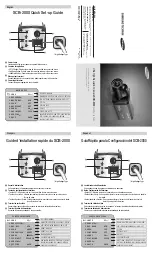
Audible and Visual Indications
The tri-colored LED (green, yellow, red) and a sounder on the detector provide local
visual and audible indication of the detector’s status as listed in Table 1.
NOTE:
The sounder and LED are not synchronized.
Table 1: Detector Status and Indication
Status
LEDs
Sounder
Radio
Signalling
Normal
Green flash every 12
seconds
Off
Normal
(none)
Alarm/Test
Red flash every 12
seconds
ANSI S3.41 temporal 4 (press
button to hush for 5 minutes)
Alarm
Detector
Trouble
Yellow flash every 6
seconds
One 100 ms chirp every 45
seconds
Fault
Low Battery
Yellow flash every
12 seconds
One 100 ms chirp every 45
seconds (press button to hush for
12 hours)
Low
battery
Detector
End of Life
Yellow flash every
23 seconds
Two chirps every 45 seconds
Fault
Power up
Green, yellow, red
flash sequence every
12 seconds
One 100 ms chirp at end of power-
up sequence
None
Tamper
Green, yellow, red
flash sequence every
12 seconds
Off
Tamper
Specifications
End of life:
5 years (see date stamped on back of detector)
Operating frequency:
915 MHz
Audible signal (temporal 4 tone):
85 dBA min. in alarm (at 10 ft (3 m))
Operating current:
16 μA
Temperature range:
4.4 °C to 37.8 °C (40 °F to 100 °F)
Operating humidity range:
15% to 93% Relative Humidity, non-condensing
Transmitted messages:
CO gas alarm, low battery, tamper, trouble
message as a result of sensor end of life or
sensor trouble, supervision.
Power source:
One 3-volt CR123A Panasonic lithium battery
(included)
Battery supervision:
Automatic transmission of battery status data as
part of any transmitted message.
Battery life expectancy:
Minimum 1 year.
NOTE
: Constant exposure to
temperature or humidity extremes may reduce
battery life.
Low battery threshold:
2.85 V
Dimension:
125.3 mm x 48.0 mm (4.9 in x 1.9 in)
Weight:
197 g (7 oz)
You should know about Carbon Monoxide.
Carbon monoxide, also known as "CO" by the chemical form, is considered to be a
highly dangerous poisonous gas, because it is colorless, odorless, tasteless and very
toxic. In general, biochemistry phenomena have shown that the presence of CO gas
inhibits the blood's capacity to transport oxygen throughout the body, which can
Summary of Contents for PG9933
Page 40: ......





































